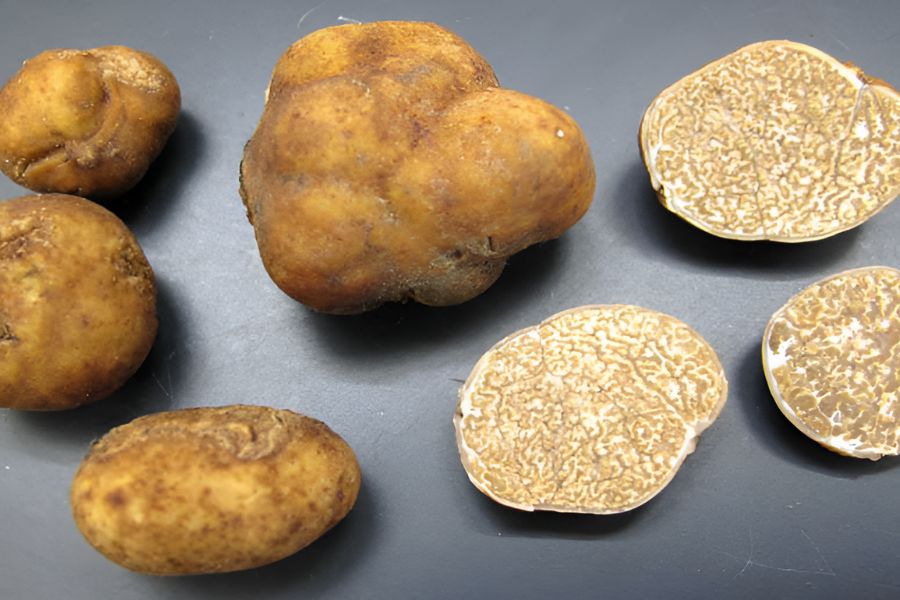Florida isn’t just beaches and palm trees—it’s also home to deep forests, rich soils, and a surprising variety of fungi growing beneath the surface. They don’t grow everywhere, but in the right pockets of forest, the conditions come together just right.
And the kicker? These things are seriously valuable. A single pound of fresh truffles can go for over $100, and if they’re dried, that number can shoot past $200. So when you find one, it’s not just a cool discovery—it’s more like striking gourmet gold.
A few spots around the state are especially well-suited for truffles. Some state forests and preserves have the perfect mix of tree cover, moisture, and undisturbed soil that these fungi love. If you’re curious where to start looking, here are a few places in Florida worth checking out.
What We Cover In This Article:
- What Wild Truffles Look Like
- Truffle Lookalikes To Avoid
- Best Practices For Finding Truffles
- Where You Can Find Truffles Around The State
- Other Great Locations For Truffles
- When The Best Time Of The Year Is To Find Truffles
- The extensive local experience and understanding of our team
- Input from multiple local foragers and foraging groups
- The accessibility of the various locations
- Safety and potential hazards when collecting
- Private and public locations
- A desire to include locations for both experienced foragers and those who are just starting out
Using these weights we think we’ve put together the best list out there for just about any forager to be successful!
A Quick Reminder
Before we get into the specifics about where and how to find these plants and mushrooms, we want to be clear that before ingesting any wild plant or mushroom, it should be identified with 100% certainty as edible by someone qualified and experienced in mushroom and plant identification, such as a professional mycologist or an expert forager. Misidentification can lead to serious illness or death.
All plants and mushrooms have the potential to cause severe adverse reactions in certain individuals, even death. If you are consuming wild foragables, it is crucial to cook them thoroughly and properly and only eat a small portion to test for personal tolerance. Some people may have allergies or sensitivities to specific mushrooms and plants, even if they are considered safe for others.
The information provided in this article is for general informational and educational purposes only. Foraging involves inherent risks.
What Wild Truffles Look Like
The U.S. is home to several native truffle species that grow wild in forests across the country. Each one has its own unique scent, appearance, and preferred habitat. Here are the types of truffles you can find:
Oregon Black Truffles (Leucangium carthusianum)
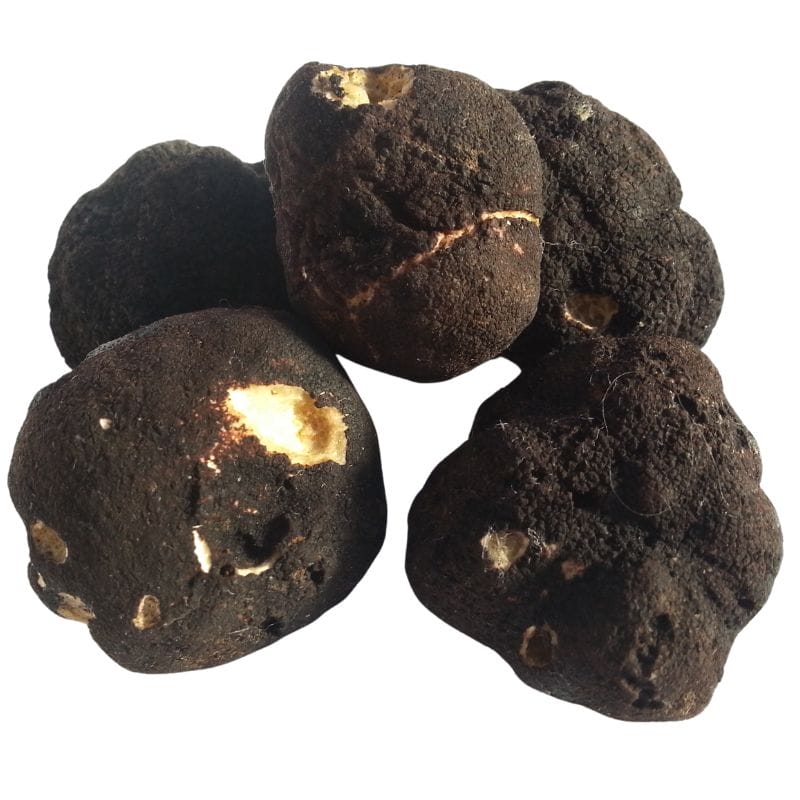
Leucangium carthusianum, also called the Oregon black truffle, grows in the Pacific Northwest and usually shows up around Douglas-fir trees. It’s a native species and one of the more well-known edible truffles from the region.
On the outside, it looks like a small lump of coal—dark black, kind of lumpy or warty, and sometimes slightly smoother in spots. They’re usually about the size of a golf ball, but they can be smaller or larger depending on the season.
Inside, the truffle is firm with a marbled pattern of gray and white veins running through it. When it’s fresh, it smells fruity, almost like pineapple, but the scent gets stronger and muskier as it ripens.
If you’re out looking for them, check in moist, shady forests with soft, loamy soil, especially where there’s a lot of moss or ferns. They grow just below the surface, so people often use trained dogs to help sniff out the ripe ones.
Compared to the Oregon white truffle, which is lighter in color and has a sharper, garlicky aroma, the black truffle has a deeper, more earthy smell. It’s also bigger and firmer than the southern U.S. truffles like Tuber lyonii, which tend to be smaller, paler, and grow around hardwoods like oaks and hickories.
Oregon Winter White Truffles (Tuber oregonense and Tuber gibbosum)
Oregon has two native white truffles that are starting to get more attention: the Oregon Winter White Truffle (Tuber oregonense) and the Oregon Spring White Truffle (Tuber gibbosum). They grow underground in forests and are prized for their strong, savory aroma.
From the outside, these truffles are small, roundish, and kind of bumpy, usually pale beige to light brown. Cut one open, and you’ll see a white interior that darkens with age, showing off a web of white veins when it’s fully mature.
The Winter White Truffle pops up from late fall into February, while the Spring White starts showing up around January and can last into June. They’re pretty similar, but the Winter variety is known for having a more powerful scent and flavor.
To find them, you’ll want to look in forests with younger Douglas-fir trees on the west side of the Cascades. Truffle hunters often check for loose soil or spots where animals have been scratching, which can be a sign there’s something below.
When fully ripe, both types give off a bold smell that’s often compared to garlic, cheese, or earthy spices. They’re usually served raw, shaved over dishes to add that truffle kick without losing any of the aroma.
Appalachian Truffle (Tuber canaliculatum)

The Appalachian truffle, also known as Tuber canaliculatum, is a native North American truffle that’s slowly getting noticed. It’s about the size of a walnut and has a reddish-brown, bumpy outer surface that looks kind of like a rough, warty potato.
When you cut it open, the inside is firm and dark brown with thin white veins running through it like a marbled pattern. If it’s fully ripe, the smell is strong and earthy—some say it has a kind of nutty, funky aroma that stands out.
You can find these truffles in mixed hardwood forests, especially around oaks and pines, from late summer through fall. They grow underground, so look for spots where the soil is loose and animals like squirrels have been digging—sometimes that’s a good clue.
If you’re foraging, gently raking the top layer of soil near tree roots can help, but a trained dog or even a good nose makes it way easier. Once you know what to look for, the reddish color and bumpy skin are good signs you’ve found the right thing.
Compared to truffles like Tuber oregonense or Leucangium carthusianum, Tuber canaliculatum is more subtle in every way. Its smaller size and lighter scent mean you have to pay closer attention when foraging.
It’s also not as popular in the culinary world because it doesn’t pack the same punch in terms of flavor or aroma. Still, finding one can be rewarding, especially if you’re exploring different types of fungi in the area.
Desert Truffle (Terfezia and Tirmania spp.)
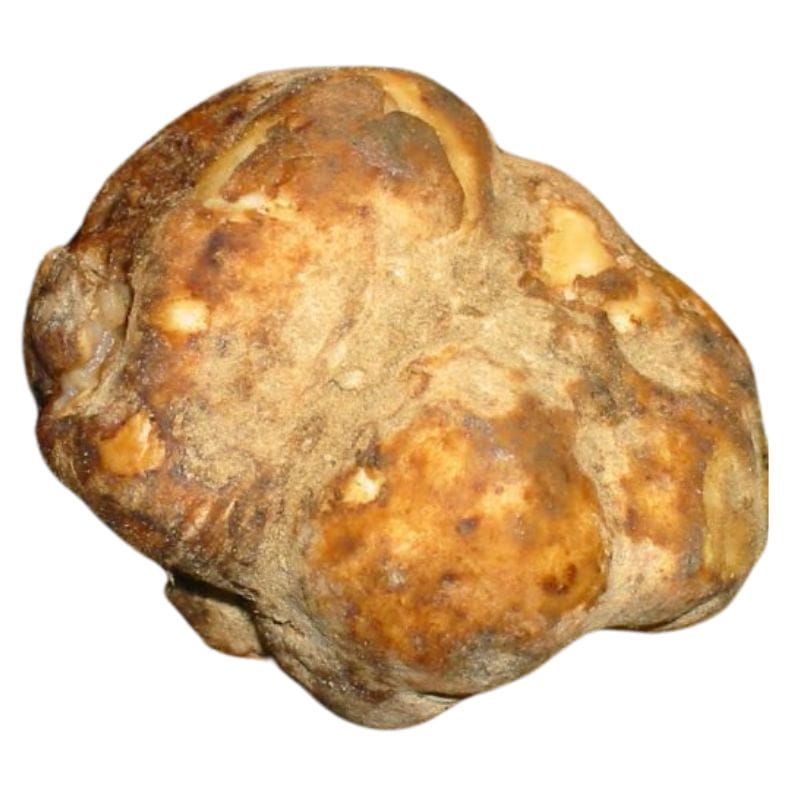
Terfezia and Tirmania are two types of truffles that are sometimes called desert truffles. These are a bit different from the truffles we usually think of, with their bold flavors and rich aromas.
These ones are a little more understated, but they’re fascinating in their own right. What makes them stand out is their ability to thrive in dry, harsh environments where you wouldn’t expect something so delicate to grow.
Unlike the earthy, intense aroma of black or white truffles, Terfezia and Tirmania truffles have a milder scent and flavor. They’re often described as nutty, with a hint of sweetness, but they lack the strong garlicky or musky notes you might associate with other truffles.
Their texture is also different—more firm and less oily than what you’d find with species like Tuber oregonense. They might not have the same culinary punch, but they’re still prized in traditional dishes, where their subtle flavors shine in simpler recipes.
When it comes to appearance, they’re easy to spot once you know what you’re looking for. They’re round to slightly irregular in shape, and their color can range from light beige to a reddish-brown, depending on the species.
The surface is usually smooth or slightly textured, without the rough, knobby look of a black truffle. Cut one open, and you’ll see a pale interior that’s often uniform in color, lacking the intricate veining you’d see in something like Leucangium carthusianum.
Pecan Truffle (Tuber lyonii)
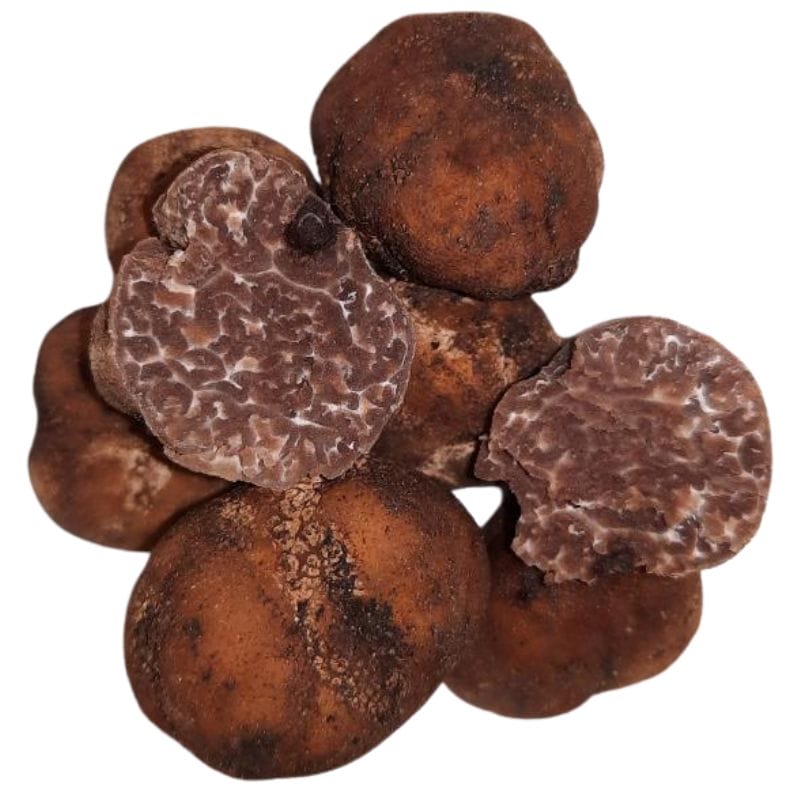
Tuber lyonii, also known as the pecan truffle, is a native North American truffle that grows underground near the roots of pecan trees. You’ll mostly find it in the southeastern U.S., especially in states like Texas, Georgia, and Mississippi.
On the outside, pecan truffles are round to lumpy and have a smooth, light brown skin that darkens as they age. They’re usually about the size of a marble or golf ball, and sometimes they even poke up slightly through the soil surface.
If you slice one open, the inside has a pretty marbled look—light tan streaks mixed with darker brown, almost like wood grain. The smell is earthy, nutty, and kind of warm, especially when they’re fully mature.
When you’re out looking for them, check under mature pecan trees or other hardwoods like oaks and hickories. Trained dogs can help sniff them out, but people sometimes spot them by looking for little cracks in the soil or raised areas near the tree’s base.
Compared to other U.S. truffles like the Oregon white truffle or the Appalachian black truffle, pecan truffles have a milder flavor and are more common in orchards. They’re a solid option in the kitchen—freshly sliced over pasta or mixed into butter—and they don’t come with the high price tag of their European cousins.
Truffle Lookalikes To Avoid
When you’re out hunting you also need to know about a few different fungi species that look very similar to the delicious truffles we’re after but are either inedible or not worth eating. Keep an eye out for:
Pine Truffles (Geopora cooperi)
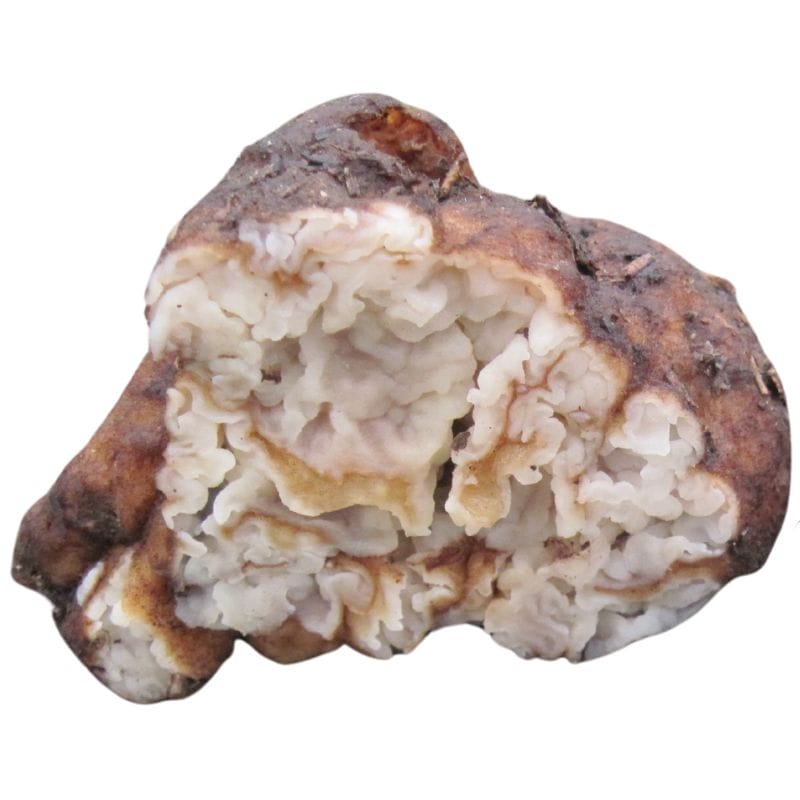
Geopora cooperi is a fungus that can easily confuse someone new to truffle hunting. It’s sometimes called the pine truffle because it grows underground like a true truffle and often pops up near certain trees.
At first glance, it might seem like you’ve hit the jackpot, but this one is a false truffle, not something you’d want to eat or sell.
The easiest way to tell Geopora cooperi apart from real truffles is by looking closely at its structure. While true truffles have a smooth or slightly knobby exterior and a marbled interior, Geopora cooperi has a rougher, more irregular outer surface.
When it matures, it sometimes splits open, revealing a cup-like shape, which true truffles never do. Inside, it’s less dense and doesn’t have the intricate veining that makes real truffles so unique.
Another big difference is the smell. True truffles have a strong, rich aroma that’s earthy, sweet, or garlicky, depending on the species. Geopora cooperi, on the other hand, has a much weaker scent, and it’s not as pleasant or distinctive.
If you’re relying on aroma to identify your find, this one will give itself away pretty quickly. So, while it might look similar at first, a closer inspection will show it’s not the culinary treasure you’re hoping for.
Stinking Slime Truffle (Melanogaster ambiguus)

Melanogaster Ambiguus, because of their reddish-brown to dark brown exterior, might look like true truffles at first glance, but they’re quite different when you know what to look for.
The key difference is on the inside. When you cut open Melanogaster ambiguus, the interior is filled with flattened cells that have a shiny black gelatinous feel to them. Real truffles, on the other hand, have those beautiful marbled veins running through their flesh, almost like a web.
Another giveaway is the smell. While real truffles have a rich, earthy aroma that’s mouthwatering, Melanogaster ambiguus tends to have a much stronger, almost unpleasant odor—it’s not something you’d want to sprinkle on your pasta.
Earthballs (Scleroderma)
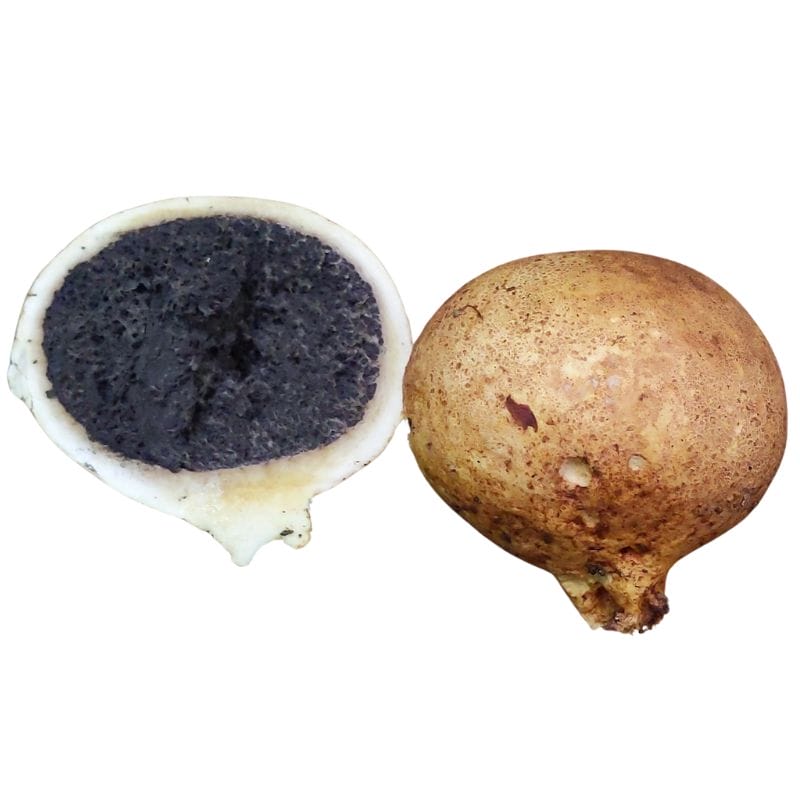
Scleroderma, commonly called earthballs, can easily fool someone who’s just starting out because they grow underground and have a round shape similar to truffles. But don’t be tricked—Scleroderma is not a true truffle, and it’s actually toxic, so it’s important to know how to tell the difference.
The first thing you’ll notice is the outer skin, which is thicker and tougher than that of most truffles. It can range in color from yellowish to dark brown, often with a rough or cracked texture.
If you cut it open, the difference becomes even clearer. While true truffles have a marbled interior with delicate white veins, Scleroderma starts out with a whitish inside that quickly darkens as it matures, turning black or purple with no marbling. It’s dense and solid, almost like charcoal in the later stages.
Another big giveaway is the smell. True truffles have a rich, earthy aroma that makes them so prized, while Scleroderma has little to no pleasant scent—some even describe it as musty or unpleasant.
Deer Truffles (Elaphomyces)
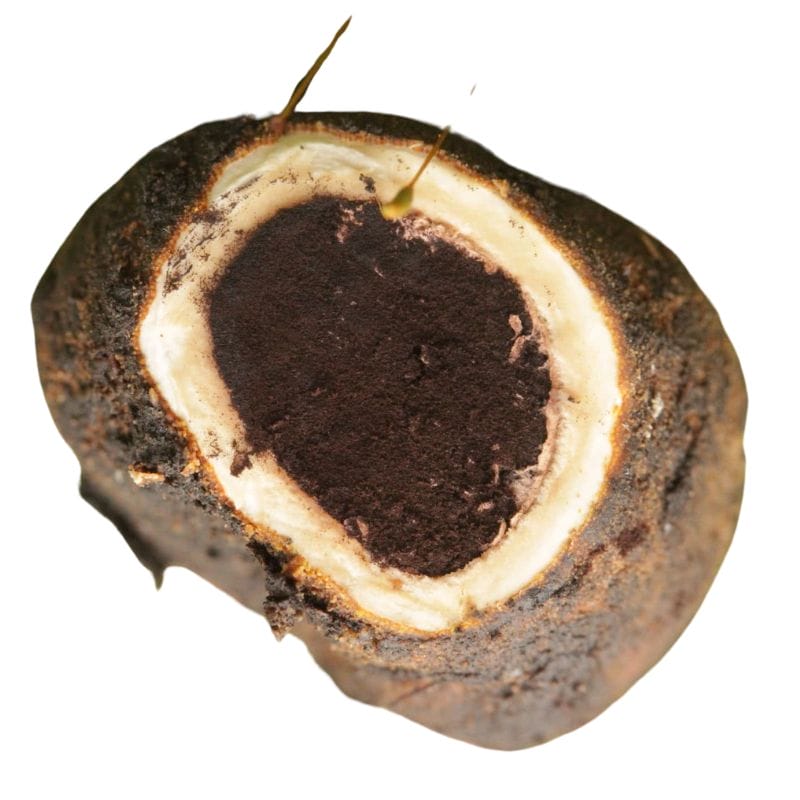
Elaphomyces, also known as deer truffles, look like true truffles at first glance, but they’re a whole different story. They’re called deer truffles because wildlife, especially deer and rodents, love to eat them. For us humans, though, they’re not edible—and definitely not what you want to mistake for a prized truffle.
Here’s how you can tell Elaphomyces apart from the real thing. First, they have a tough, warty outer surface that can range from pale tan to black, depending on the species and their age.
When you cut them open, the inside is solid and sometimes speckled or marbled, but not in the delicate, vein-like pattern you’d see in true truffles.
Their smell is also a big giveaway. Instead of the rich, earthy aroma of an edible truffle, Elaphomyces either has little scent or an odor that’s earthy but not particularly appealing.
Another thing to know is that Elaphomyces often grows deeper in the soil than true truffles, and they tend to have a harder, woodier texture.
Best Practices For Finding Truffles
Truffle hunting can be a rewarding adventure if you know the right tips and tricks. Here’s what you should keep in mind to improve your chances of finding these underground treasures:
Wait 10 to 14 Days After Heavy Rain
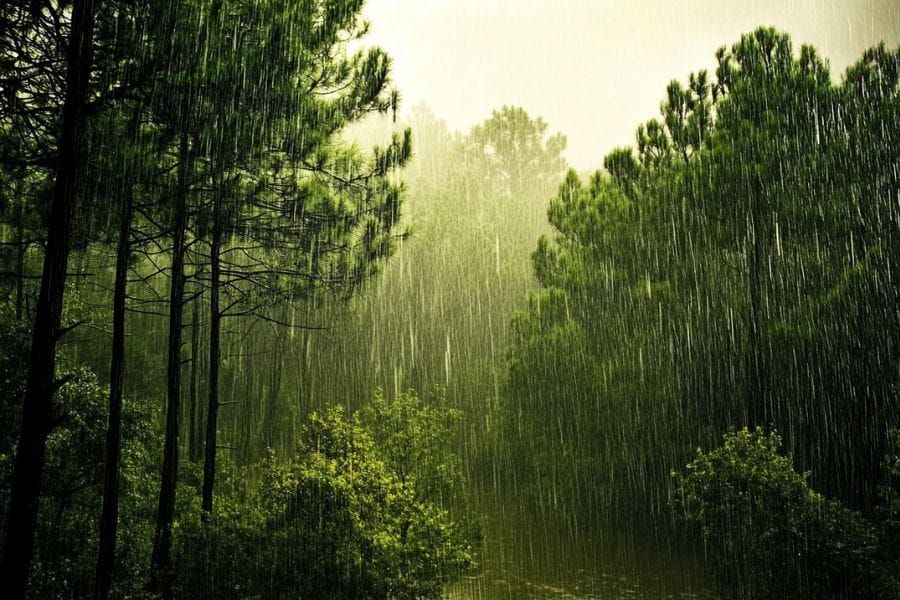
After a heavy rain, it’s best to wait about 10 to 14 days before heading out. This gives the truffles time to mature and release their signature aroma, making it easier for you (and your dog) to sniff them out. Rain helps truffles grow, but they don’t start giving off their scent right away.
As the soil warms up, the truffles get more aromatic, and the ground becomes looser, which makes digging easier without disturbing the environment too much. The timing is perfect to find truffles at their best—both in quality and in how easy they are to locate.
Find the Right Trees
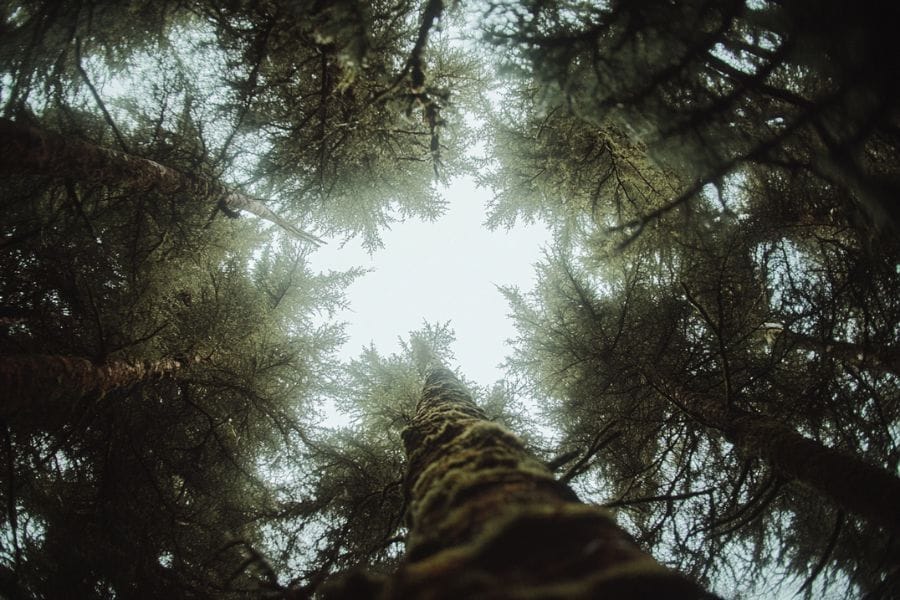
Truffles don’t grow just anywhere—they have a special relationship with certain trees. You won’t find them under just any tree, so knowing which ones to look for can make all the difference. Some of the best trees to look out for are:
- Pines
- Douglas-firs
- Oaks
- Hazelnuts
- Cypresses
- Willows
For example, if you’re looking for Oregon white truffles, keep an eye out for Douglas-fir trees. California black truffles, on the other hand, are often found near oaks and hazelnuts. The soil around these trees also needs to be slightly alkaline, so it helps to know what kind of ground you’re walking on as well.
Watch for Wildlife Activity
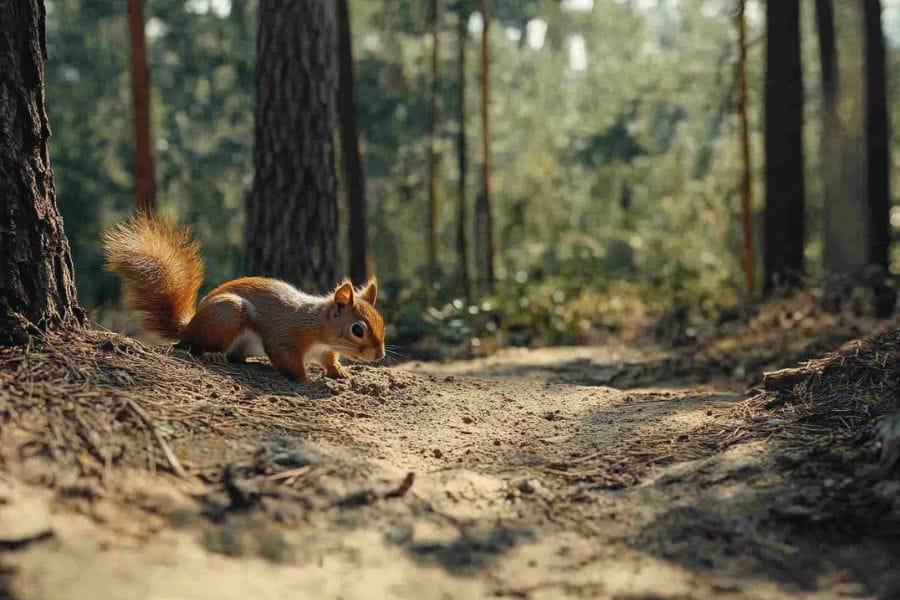
Animals like squirrels and chipmunks often help spread truffle spores, and sometimes their digging can lead you straight to truffles. While you won’t always find truffles in every pit animals dig (they also look for things like acorns or bulbs), fresh digs are a good clue. The more recent the pit, the better chance it has of leading to truffles.
Even though animals are a part of the truffle cycle, most hunters prefer using dogs to find the real treasure underground. Dogs have an incredible nose for truffles and can pinpoint their location much more reliably than any squirrel or chipmunk.
Get a Little Help from a Truffle-Hunting Dog
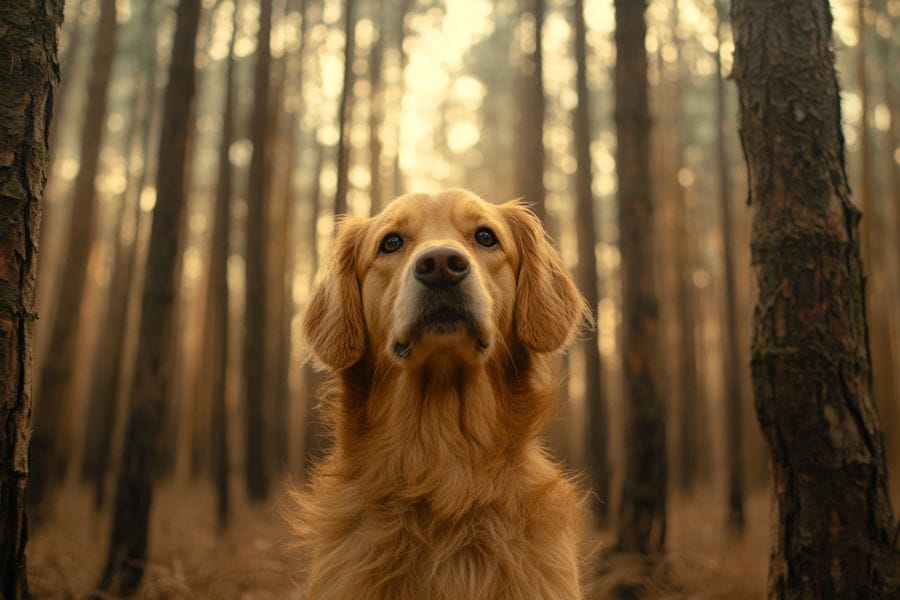
If you’re serious about truffle hunting, a trained dog can make your life a whole lot easier. Their sense of smell is extraordinary, and they’re trained to find mature truffles buried beneath the surface. Many truffle hunters swear by their dogs, and for good reason—they’re much more accurate than humans when it comes to sniffing out truffles.
If you don’t already have a trained dog, you can connect with local foraging groups or specialized trainers who offer truffle-hunting services. Some places even host events where you can see experienced handlers with their dogs in action. And if you’re feeling adventurous, you can train your own dog using truffle-scent kits and practice in a controlled space before hitting the woods.
Before you head out
Before embarking on any foraging activities, it is essential to understand and follow local laws and guidelines. Always confirm that you have permission to access any land and obtain permission from landowners if you are foraging on private property. Trespassing or foraging without permission is illegal and disrespectful.
For public lands, familiarize yourself with the foraging regulations, as some areas may restrict or prohibit the collection of mushrooms or other wild foods. These regulations and laws are frequently changing so always verify them before heading out to hunt. What we have listed below may be out of date and inaccurate as a result.
Where You Can Find Truffles Around The State
Now we’re going to go over five of the best locations for finding truffles. We’ll go a bit in-depth here and then provide a much longer list of other spots to try.
Big Cypress National Preserve
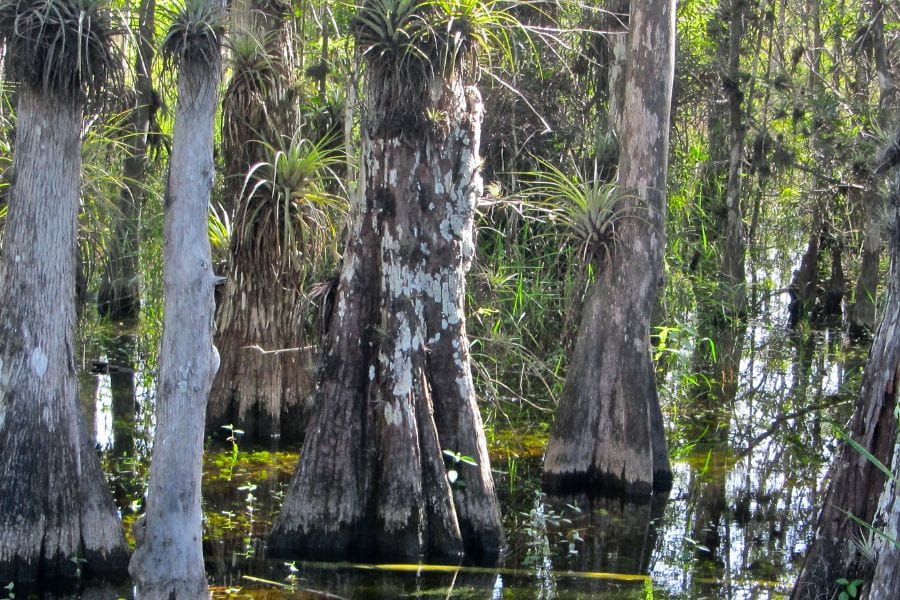
Big Cypress National Preserve is massive, with over 700,000 acres of swampy, wild terrain sitting on a limestone base that feeds into the Everglades. A good place to start hunting for truffles is along Turner River Road, after the seasonal flooding pulls back.
Loop Road is another solid bet, especially near the Gator Hook Trail. This hidden little trail cuts through old dwarf cypress forests, and the soil back there stays shaded and undisturbed—perfect for the fungi that help truffles grow around native tree roots.
Further north, Bear Island gives you yet another shot. It has pine flatwoods and hardwood pockets that have a reputation for turning up truffles in Florida. The roads can be a bit rough, but if you can get in, the damp, root-rich soil between the wetlands is the kind of spot that delivers.
Apalachicola National Forest
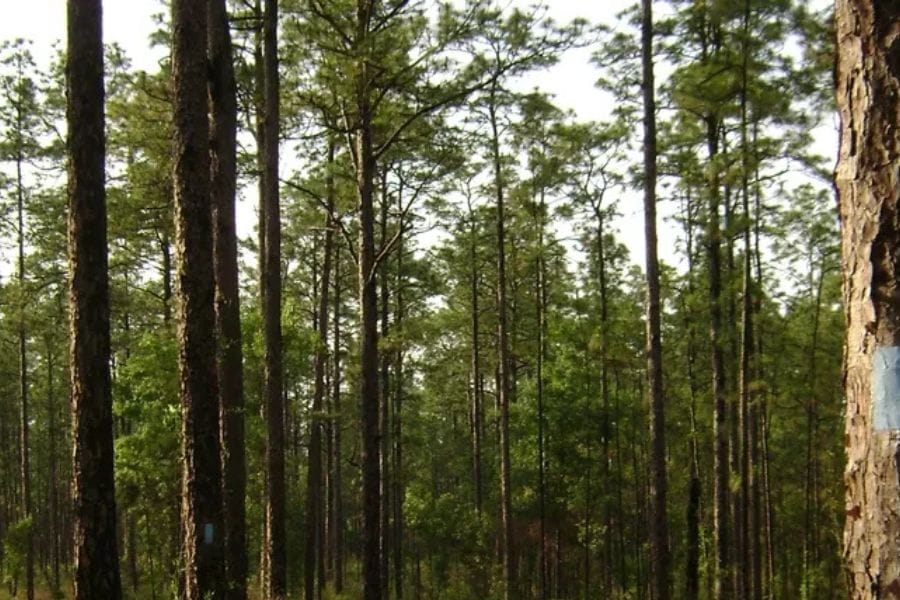
Apalachicola National Forest is the largest national forest in Florida, offering a mix of pine flatwoods and hardwood swamps. It has more than a few hidden corners worth checking out for truffles. Bradwell Bay Wilderness, with its old-growth swamp forest and rich, dark soil, is one of the best spots in the whole forest.
Up in the northern part of the forest, Leon Sinks Geological Area is worth a visit. The sinkholes and hardwood hammocks there have little pockets of oak and hickory, which are great trees for truffle growth.
If you’re headed west, Wright Lake Recreation Area is surrounded by a nice mix of hardwoods and pines. Just a short drive away, Camel Lake has older sandhill pine habitat that’s ideal for truffle growth.
Ocala National Forest
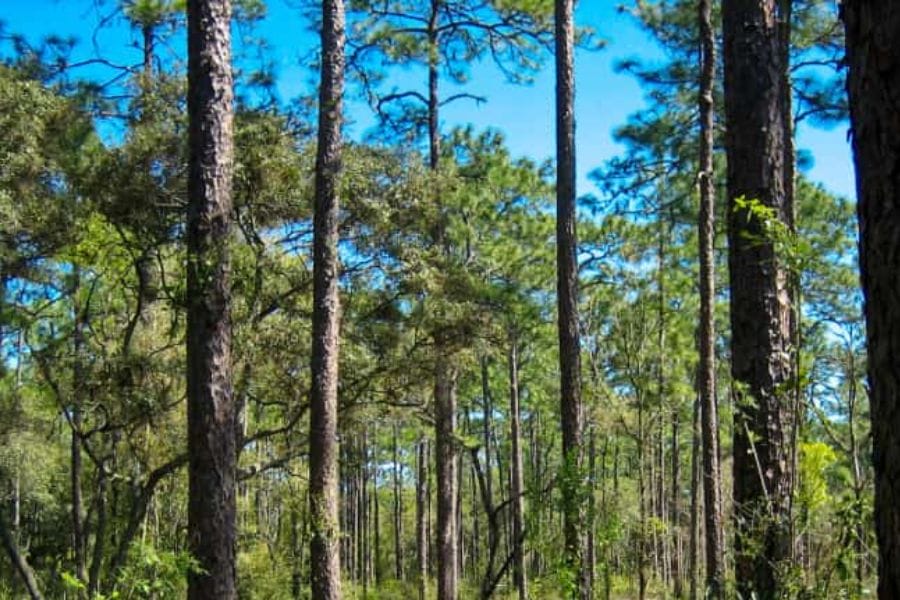
Ocala National Forest is the southernmost national forest in the continental US, and it has some great spots for truffle hunting. Juniper Springs Recreation Area is a top contender, with its shady hardwood hammocks and a steady mix of oak and pine that keeps the soil moist and the fungi happy.
Just a short hop away, Alexander Springs Recreation Area offers a similar setup with a little extra humidity, thanks to its flowing spring and stream system. The woods around it are full of native trees and undisturbed ground, both of which are key ingredients when you’re looking for truffles in the wild.
Head north and you have a couple more strong leads: Salt Springs and Clearwater Lake. Salt Springs is loaded with rich, dark soil under a thick hardwood canopy, and Clearwater Lake has that classic pine-and-hardwood blend in a calm, shaded setting.
Withlacoochee State Forest

Withlacoochee State Forest is one of Florida’s most ecologically diverse public lands, and that variety makes it a solid place to go truffle hunting. In the Citrus Tract, you’ll find a mix of sandhills and hardwood hammocks where oaks and pines grow in dry, sandy soil, which provides ideal conditions for truffle-producing fungi.
Over in the Richloam Tract, things get wetter and a bit more wild. This area’s mature hardwoods and floodplain hammocks create shady, humid environments near streams where underground fungi thrive.
Up north in the Croom Tract, you get a patchwork of scrub and hardwoods that’s worth exploring. Not too far away, Johnson Pond sits in a quiet, low-lying basin surrounded by native trees and rich, damp soil—another spot where truffles could definitely be hiding out.
Blackwater River State Forest
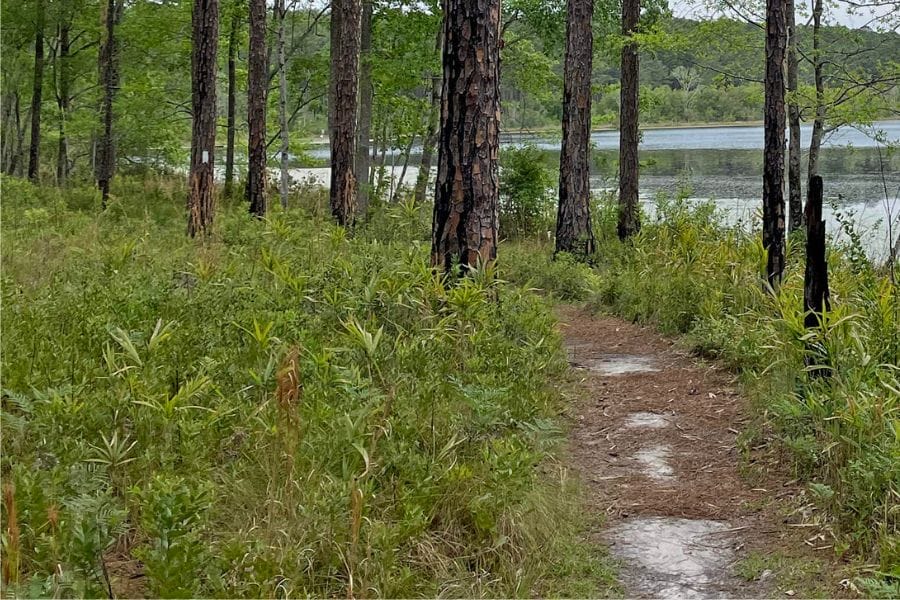
Blackwater River State Forest is Florida’s biggest state forest, and its dark, slow-moving river cuts through a landscape that’s surprisingly good for truffle hunting. One of the top spots is the Krul Recreation Area, where hardwoods and pines circle a clear, spring-fed lake.
Head a bit north and you’ll hit Bear Lake Recreation Area, where the forest shifts into a mix of upland pine and hardwoods. The trail system here makes it easy to explore some of the more promising pockets without having to bushwhack too hard.
Deeper in the woods, Juniper Creek Trail and the Chain of Lakes Nature Trail both offer some real potential. These trails cut through shaded, leaf-littered forest and hug creeks that help keep the soil cool and damp.
Other Great Locations For Truffles
North Florida
| Location | Foraging Information |
|---|---|
| Apalachicola National Forest | Foraging for personal use is allowed; commercial harvesting requires a permit. |
| Blackwater River State Forest | Personal collection of non-protected species is permitted; adhere to state forest guidelines. |
| Cary State Forest | Allows foraging for personal use; ensure compliance with forest regulations. |
| Etoniah Creek State Forest | Permits personal foraging; follow all posted rules and guidelines. |
| John M. Bethea State Forest | Foraging for personal consumption is allowed; be mindful of protected species. |
| Lake Talquin State Forest | Personal use foraging is permitted; adhere to forest management policies. |
| Osceola National Forest | Allows foraging for personal use; commercial activities require appropriate permits. |
| Pine Log State Forest | Personal collection of non-protected species is allowed; follow state forest regulations. |
| Tate’s Hell State Forest | Permits personal foraging; ensure adherence to forest guidelines. |
| Twin Rivers State Forest | Foraging for personal use is allowed; respect all conservation efforts in place. |
| Wakulla State Forest | Allows personal foraging; adhere to forest management and conservation policies. |
Central Florida
| Location | Foraging Information |
|---|---|
| Charles H. Bronson State Forest | Personal use foraging is permitted; follow all forest regulations. |
| Goethe State Forest | Allows foraging for personal consumption; adhere to state forest guidelines. |
| Green Swamp Wilderness Preserve | Foraging is allowed for personal use; ensure compliance with preserve rules. |
| Lake George State Forest | Permits personal foraging; follow all posted regulations and guidelines. |
| Little Big Econ State Forest | Foraging for personal use is allowed; be mindful of protected species and habitats. |
| Ocala National Forest | Allows personal foraging; commercial harvesting requires appropriate permits. |
| Seminole State Forest | Personal use foraging is permitted; adhere to forest management policies. |
| Tiger Bay State Forest | Permits foraging for personal consumption; follow all forest regulations. |
| Withlacoochee State Forest | Allows personal foraging; ensure adherence to state forest guidelines. |
South Florida
| Location | Foraging Information |
|---|---|
| Babcock Ranch Preserve | Foraging for personal use is allowed; adhere to preserve regulations. |
| Big Cypress National Preserve | Allows personal foraging; commercial activities require appropriate permits. |
| Fakahatchee Strand Preserve | Personal use foraging is permitted; follow all preserve guidelines. |
| Picayune Strand State Forest | Permits personal foraging; ensure compliance with state forest regulations. |
| Okaloacoochee Slough State Forest | Foraging for personal consumption is allowed; adhere to forest management policies. |
Northeast Florida
| Location | Foraging Information |
|---|---|
| Belmore State Forest | Personal use foraging is permitted; follow all forest regulations. |
| Four Creeks State Forest | Allows foraging for personal consumption; adhere to state forest guidelines. |
| Ralph E. Simmons State Forest | Foraging is allowed for personal use; ensure compliance with forest rules. |
Northwest Florida
| Location | Foraging Information |
|---|---|
| Blackwater River State Forest | Personal collection of non-protected species is allowed; follow state forest regulations. |
| Point Washington State Forest | Permits personal foraging; adhere to forest management policies. |
Southwest Florida
| Location | Foraging Information |
|---|---|
| Myakka State Forest | Foraging for personal use is allowed; adhere to state forest guidelines. |
Southeast Florida
| Location | Foraging Information |
|---|---|
| Holopaw State Forest | Personal use foraging is permitted; follow all forest regulations. |
When The Best Time Of The Year Is To Find Truffles
The best time to hunt for truffles in Florida typically falls during the cooler months, from late fall to early spring. These months provide the right combination of moisture and moderate temperatures for truffle growth.
After a period of heavy rain, waiting 10-14 days allows the soil to stabilize and the truffles to mature, enhancing their aroma. Focus on mornings or cool, overcast days to improve conditions for foraging, as truffle scent is more pronounced in cooler, damp environments.
Seasonal timing is key, as Florida’s warm, humid climate can impact truffle availability outside of these optimal months.
One Final Disclaimer
The information provided in this article is for general informational and educational purposes only. Foraging for wild plants and mushrooms involves inherent risks. Some wild plants and mushrooms are toxic and can be easily mistaken for edible varieties.
Before ingesting anything, it should be identified with 100% certainty as edible by someone qualified and experienced in mushroom and plant identification, such as a professional mycologist or an expert forager. Misidentification can lead to serious illness or death.
All mushrooms and plants have the potential to cause severe adverse reactions in certain individuals, even death. If you are consuming foraged items, it is crucial to cook them thoroughly and properly and only eat a small portion to test for personal tolerance. Some people may have allergies or sensitivities to specific mushrooms and plants, even if they are considered safe for others.
Foraged items should always be fully cooked with proper instructions to ensure they are safe to eat. Many wild mushrooms and plants contain toxins and compounds that can be harmful if ingested.

